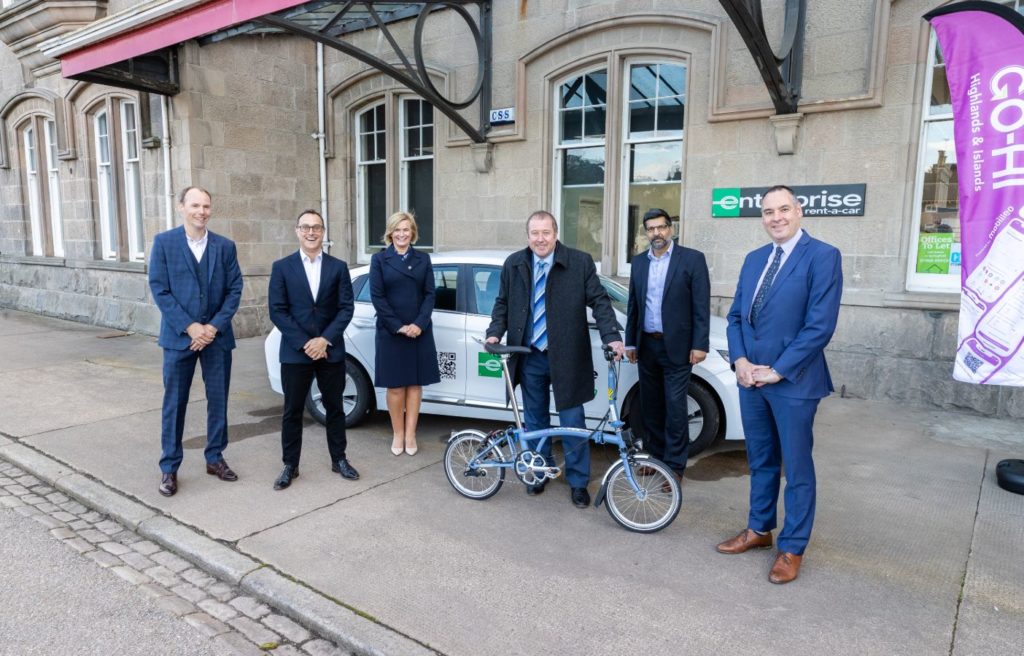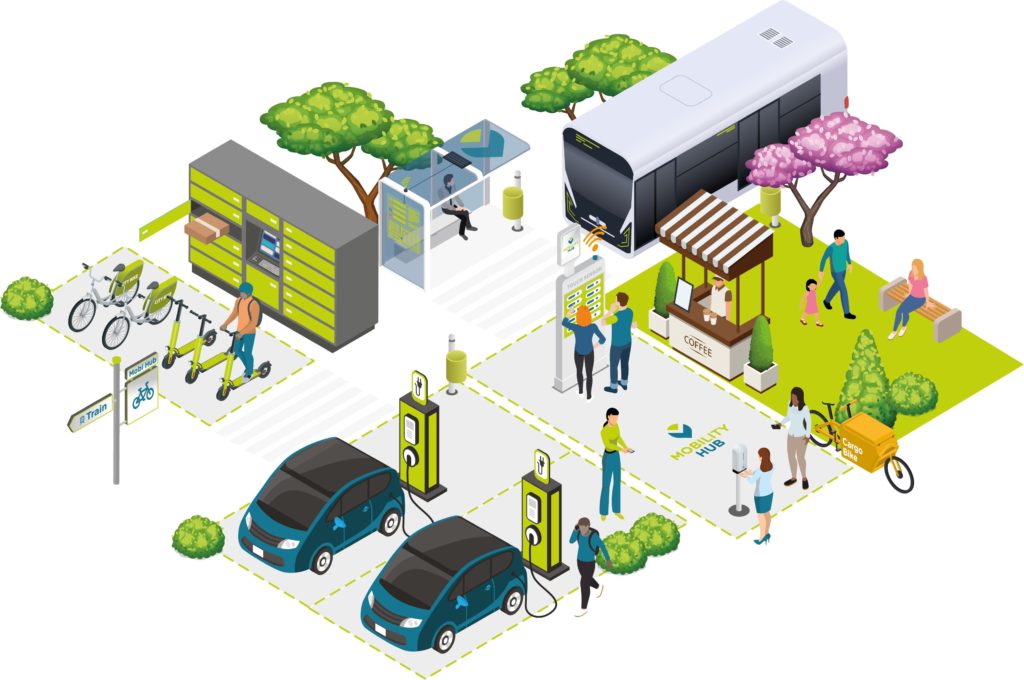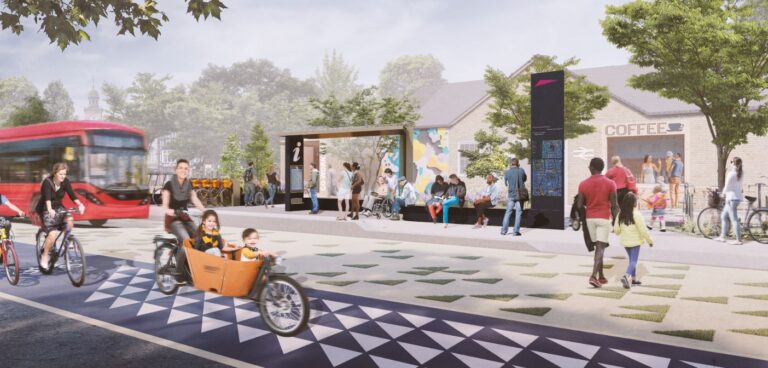Could clustering together complementary green transport options in visible mobility hubs help cities get residents out of private cars? Katie Searles reports…
Mobility hubs – dedicated locations where a range of sustainable transport modes are co-located in close proximity – are a growing sight on city streets. Designed to be recognisable, these hubs aim to help cities address air quality issues, support active travel agendas and fight congestion. With public transport – the original shared mode of transport – often used as a starting point, mobility hubs can also work to get people back on buses and trains through connectivity with first- and final-mile solutions.
And, if deployed successfully, these hubs could result in public transport and active travel networks that could eliminate the need to own a private vehicle, believes Richard Dilks, chief executive of shared transport charity Collaborative Mobility UK (CoMoUK). “It isn’t just about getting people out of petrol and diesel cars and into electric ones. Cars have lots of other impacts as well – the space they take, congestion, noise, etc. Mobility hubs are part of lots of different areas of debate, ideas and practice. They can, if done well, really help with a lot.”
Mihir Benison, associate at British multinational professional services firm Arup, which published a 38-page report on the future of mobility hubs in September 2021 in collaboration with passenger transport company GoAhead Group, agrees. “Private cars these days, especially EVs, are so costly and out of the reach of a lot of people on average incomes. When we think about equality and levelling up, cars are prohibitively expensive to buy new, especially right now as fuel and energy costs soar. There’s almost a natural break there.”
Thus, CoMoUK, Arup, local authorities and transport operators are currently working to define what mobility hubs actually are and understand how they should work in the real world. According to Benison, for mobility hubs to be successful, operators need to “really understand what the user needs within the community, within the locality where the mobility hub networks are planning to be set up. And only through doing that, can we really understand what that behavioural change might be and the propensity to change as well, because it’s going to be different in different places.”
From John o’Groats to Land’s End
In the UK, councils the length and breadth of the country are currently working on their own forms of mobility hubs to trial and test these solutions, including Plymouth City Council, Nottingham City Council and Highland and Islands Transport Partnership (HITRANS) in Scotland, which aims to incorporate its Mobility-as-a-Service (MaaS) app, launched last summer, into mobility hub trials across Inverness, Elgin and potentially Drumnadrochit for the tourist trade at Lochness.
“We’ve got the ability to digitally bring together and cluster transfer services through the MaaS platform,” explains Ranald Robertson, director HITRANS. “We’re now trying to employ the same principle for the clustering of the actual mobility service providers and integrate ones that will be integrated with the platform.”
The HITRANS hubs will be “anchored” around the region’s bike share programme, with scope for including car clubs, e-cargo bikes and EV charging stations. The team is currently investigating locations including university campuses, Inverness Leisure Centre, Raigmore Hospital and Elgin rail station. It would also like to see hubs installed at supermarkets, thereby enabling residents without access to a car or those thinking of giving up their private vehicle, to still be able to do their shopping.

The Plymouth scheme forms part of a programme of investment through the UK government’s Transforming Cities Fund (TCF) to collectively help reduce congestion, improve air quality and help the city prosper by investing in infrastructure to improve public and sustainable transport connectivity on key commuter routes across the city. The aim is to deliver significant carbon reductions, improved connectivity, business benefits and a sustainable, future-proofed shared transportation system.
“The current climate, locally, nationally and globally means we require a re-evaluation of how we move, use space and travel,” says John Green, low carbon city officer, strategic planning and infrastructure, Plymouth City Council. “There is an urgent need to improve air quality, reduce carbon emissions, lessen congestion and improve connectivity in a fair and affordable manner. “Mobility hubs will, by tackling these key issues, serve to improve health and wellbeing, strengthen the economy, minimise negative environmental impact, regenerate communities and reduce poverty.”
After the three-year TCF grant period Plymouth aims to have installed up to 50 multimodal mobility hubs, strategically integrated into the public transport network. These will consist of 300 EV chargepoints, 400 e-bikes, a car club, 0.5MW of solar carports and a smart journey planning system. Residents, employees, businesses and visitors will be able to plan their journeys to use public and shared transportation, both in the city and on the main routes into Devon and Cornwall.
In the East Midlands, Nottingham City Council has partnered with Derby City Council on three electric mobility hubs to improve connectivity across the region, as well as encourage both public transport and active travel. These hubs will be based in neighbourhoods, at campuses and depots, offering electric car club hire, electric bike sharing, vehicle charging point and digital information screens featuring real-time public transport information.
The £16.7m project follows a successful bid for grant money from the UK Department for Transport’s, £70m Future Mobility Strategy, which will also see the funding used to create a new website and smartphone app that will allow users to plan, book and pay for public transport, car sharing, bike hire and vehicle charging online. A data platform is also being created that will pool various data from council-owned transport systems to improve the efficiency of traffic control and keep commuters informed with the latest information.
Rasita Chudasama, innovative transport manager, Nottingham City Council, says: “Beyond the immediate transport benefits, the hubs project also seeks to promote a greater sense of place through public realm improvements in a manner that is attractive, safe and durable.”
What’s more, Nottingham will look to include novel and alternative modes into the hubs such as e-scooters and, one day, autonomous vehicles. However, Chudasama admits there are lessons to be learned first. “The hubs concept is currently untested in the UK at scale so there is not a wealth of evidence available. Thus, we intend to pilot a series of hubs across the city to test how they work and what benefits they bring, to learn whether there is any potential to scale this up and introduce them more widely.”

No one-size-fits-all approach
As different cities, towns, suburbs, and even rural villages require different transport modes, no one mobility hub take the same form as another. Many feature different component that can be added to and exchanged, but there is no hard and fast rule as to what makes a mobility hub. For example, in the London Borough of Redbridge, two car parking spaces have been reclaimed, with a design aimed at connecting the area and helping the environment.
The South Woodford hub – the first to receive CoMoUK accreditation – features an electric car club bay, a community-led café and an outdoor seating area with bar stools and coffee tables, as well as a garden area. It includes an EV fast charger from EB Charging and space for car club Ubeeqo, with two Renault Zoe electric cars available. The hub also provides wider transport connections through the local underground station and bus stops metres away.
“That particular scheme shows that mobility hubs don’t have to be large and expensive or take lots of time to implement. It’s simply a couple of parking spaces re-purposed,” says Dilks, before adding that such micro hubs can also work to improve public realm and bring together communities – whether through shared gardens, local amenities such as mobile doctor surgeries or banking buses, as well as becoming a place where fitness classes happen. “Hubs will be found ultimately to be part of decarbonisation, and the mode shift away from higher emitting sources toward nicer places with cleaner air,” Dilks notes.
Getting it right
As there is no “one-size fits all” design and mobility hub solutions are yet to be fully understood in the UK, there are wider challenges to overcome, and not just in choosing what modes are clustered together. For payment, Benison says: “Is there an integrated payment system with a clear fare structure and information that gives you clarity on your end-to-end journey?”
Additionally, site selection must be addressed, whether it is changing the purpose of a public space or building new. According to Dilks, a balance must be struck between ensuring users of mobility hubs have the options and convenience they require while taking into consideration any inconveniences for non-users. The sites require sufficient density for residents, businesses and any through traffic, and must be accessible for all, considering the needs of those with disability, as well as feeling safe for all users with suitable lighting.
Dilks also stresses the importance of clarity and transparency with all parties involved, through public consultation with the local community, meetings with transport providers, utility providers and environmental services. Furthermore, promoting the benefits to all involved will be a critical step in the success of the UK’s mobility hubs. “We want to be using these hubs as agents of change, this is about providing sustainable options to people in a really attractive, easy to access way and achieving behaviour change, something different,” Dilks concludes.
European examples
The concept of mobility hubs may be an idea the UK is coming to terms with, but shared transport facilities have been embraced in Europe for nearly two decades. In 2003, the German city of Bremen began planning mobility hubs on existing public street space that could link several forms of transport. There, large hubs, often situated near public transport stops and featuring local amenities, are called mobil.punkte, while smaller ones located in residential areas are signposted as mobil.pünktchen.
Bremen has reported that its mobility hubs and car sharing have contributed to a decrease of more than 6,500 privately-owned cars in the city. As a result, Bremen now aims to develop a network of 100 mobility hubs with a maximum distance of 300m between each hub. This template has also been adopted in Bergen, Norway where a series of mobility hubs have been rolled out at key locations across the city as part of wider plans to remove street parking for private cars. Elsewhere, in Flanders, Belgium work is underway to study the transport needs of the region to shape a shared mobility ‘matrix’, intended to encourage local and regional involvement in delivering a standardised mobility hub provision.
Staying in Belgium, the city of Ghent has reduced the number of car journeys from 55% to 27% through the introduction of shared mobility options. The winner of the Carshare Regional City Awards now aims to expand its shared bike schemes, ensuring half of all shared cars are electric and reach its target of 25,000 car sharing users by 2025.CoMoUK’s Richard Dilks can’t see why this success cannot be replicated in the UK. He notes: “If you look across the world at the big, successful behaviour change moves relating to transport, you’re going to want to look at different conditions. Look at how Amsterdam and the Netherlands restore so much of its bike mode share – it didn’t just do anti-car stuff, it also provided a really high-quality cycling network.”
New builds
Using existing public transport sites and re-purposing car parking spots are two ways to approach the mobility hub concept, but there is also an opportunity to build from the ground up. “Housing developments – there’s a huge set of use cases there,” says Richard Dilks of CoMoUK. “It’s really important to not build in future private car use, certainly to any excessive level, and instead centre things on sustainable transport options that will directly decarbonise and have a long-term decarbonising benefit, which, over decades, becomes enormous.”
The transport charity has already seen some success with integrating mobility hubs into new large-scale housing developments in East Calder, Scotland. The Calderwood site, which features new houses, business development units and community facilities, has its own dedicated hub served by two main bus routes, an EV car club and cycle parking. It is also located near a national cycle route that follows the Forth & Clyde canals between Glasgow and Edinburgh.
“Delivering Scotland’s first mobility hub was not a requirement of our planning consent, but our business recognises the importance of sustainable growth and assisting the region to achieve climate change objectives,” says Peter Stirling, managing director of Stirling Developments, the planner and developer behind the new village.
This article originally appeared in the June issue of CiTTi magazine.





